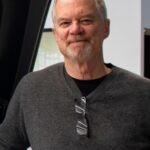The development of new products and processes does not stop at the exterior walls of your company. Outside suppliers play critical roles in development, but the relationships between companies and suppliers often resemble cage fighting. That’s where the innovative “matched pair” process comes in to dramatically improve these relationships as well as business performance.
LEI Communications Director Chet Marchwinski learned more about the matched pair method at the annual Designing the Future Summit where he interviewed a former matched pair of executives.
Susan DeSandre was a supply chain executive at Ford Motor Company and later Apple where she was responsible for large global supply bases. She now serves as an advisor to Roechling Automotive in Mannheim, Germany, and as a board member of TheatreUntitled a startup nonprofit theater company in New York.
Jim Morgan, former COO of electric vehicle startup Rivian, was a global engineering director at Ford during the product-led turnaround under former CEO Alan Mulally. He is a Shingo Prize winning author, whose latest book, co-authored with Jeff Liker, is Designing the Future. He also is senior advisor on lean product and process development (LPPD) at the nonprofit Lean Enterprise Institute.
Watch a video of their conversation on the YouTube LPPD channel here.
Q: You both worked at Ford under CEO Mulally as a matched pair of leaders from engineering, Jim, and purchasing, Susan. What’s the purpose of the matched pair concept; what problem did it solve?
Susan: Matched pairs were born out of necessity. At the time, the Ford Motor Company had very dismal operating results, we had mediocre product quality, and our vehicle lines were in need of upgrades. It was also a time when Ford had silos down to a real science. We didn’t talk to each other well across the functions. We were a very strong functional organization and senior leadership believed we needed a change. Allen came in and was the biggest proponent of relationships of any leader that I have ever worked for. Matched pairs had started before he arrived, but they didn’t take off until he was on the scene.
Q: Jim, what are the advantages of a matched pair?
Jim: In the automotive industry, just like most industries, you’re very reliant on your suppliers’ capabilities. In fact, depending on what study you look at, up to 60 or 70 percent of the content of any vehicle rolling down the assembly line is provided by suppliers. If you don’t have strong relationships with them, it creates tremendous difficulties in product development.
The matched pair process enabled purchasing and engineering to align around their objectives and goals and enabled better discussions and better partnerships with our key suppliers so that we could be more successful in our product development and the quality of our products. It was a huge enabler for the improvement that we saw during the Mulally period as we learned to work together.
I talk a lot these days about lean product development being an enterprise thing. It’s not an engineering thing. You really need to engage the whole organization in this. And Susan is one of the people, quite frankly, who taught me how important suppliers were and how important it was to work well with our suppliers, with our purchasing partners as well, in order to do that.
Q: Can each of you give some details about how the process worked; did you co-locate?
Susan: We didn’t co-locate but we spent an awful lot of time together. We probably would’ve co-located had there been the physical space to do it. The way that it worked was that Jim and I were the executive partners leading a segment of the business. For example, we led the global body and exterior purchasing in product development teams. That was a global role so every Ford and Lincoln vehicle around the world — any body exterior components, and systems were the responsibility of our teams.
We did it together in conjunction with manufacturing and finance and all the other organizations. But there was an infrastructure because Ford is a very process-oriented company and so an infrastructure came with it. We had facilitated sessions, we had templates, we had commodity business plans, strategies; we had to do design strategies, we did supply strategies, negotiation strategies. Engineers from Jim’s team with buyers and global supply managers from my team would develop and implement those strategies.
That was the essence of how the matched pairs worked. We, for example, had a meeting cadence of every Monday morning from 7:00 a.m. until noon every week, week in, week out; we would lead our matched pair teams and through all things body exterior.
Q: How was this aligned; did it extend down through both your organizations?
Susan: All the way down.
Q: Wow. And Jim, why were engineering and purchasing selected; why not engineering and marketing?
Jim: I think it goes back to what I mentioned earlier about how important the supply base is to the survival of an OEM [original equipment manufacturer]. Susan mentioned the difficult time that we were in at that point. It also included the fact that I think we were lowest on the supplier survey.
Susan: We won the race to the bottom.
Jim: That’s right. And so Ford was the organization suppliers liked working with the least. And you pay a tremendous penalty for that, quite frankly, when nobody wants to work with you in terms of new technologies or even getting their best players to engage with us. I mean there’s a lot of hidden penalties to being at the bottom of that survey. And so I think that’s another reason why purchasing and engineering were really key in working together.
Over the years, the “silo-ism” Susan mentioned meant that engineering and purchasing didn’t talk much. And they often had opposing objectives. So a typical PD engineer would talk to a supplier and say, “You know, I want you to do this and this and this and this.” And then purchasing would come along and say, “You know, do whatever you want, but we’re not paying for any of that stuff.”
Susan: We wouldn’t do that.
Jim: Yeah, never. So, suppliers would get mixed signals. They weren’t sure who was Ford Motor Company. So I think at the time it was really important for us to align ourselves around the supply base.
Q: Did a team of purchasing and product development engineers start meeting as a team with suppliers?
Susan: Yes, we did. One of the things that Jim and I did and our colleagues did as well was make visits to supplier sites often coinciding with our annual planning processes. Jim and I traveled the world together and would meet with supplier executives at their facilities. When you break bread with suppliers and you demonstrate to them on their turf, it really is, it is a demonstration of your commitment and it yielded some pretty powerful results.
Q: You won the “race to the bottom” of the supplier survey but this matched pair process had a pretty positive impact on changing that.
Susan: Yes. That wasn’t the end of the story. In 2007 the supplier survey was conducted mid-year. It had started in the early 2000s by an outside consultant. So by 2005-6, we were just ahead of General Motors. And in 2007 we flipped and won the race to the bottom. Matched pairs coincided with something we called Aligned Business Framework (ABF), which was a set of principles and commitments that we made to the suppliers.
ABF in conjunction with matched pairs yielded really fabulous results. We found that in the supplier survey, the performance results of the OEMs correlated with business performance results. So by 2010 and 11 when Jim and I had worked for several years through some pretty dark days, the Ford results in the supplier survey correlated with positive business results. We escalated from the bottom, shot nearly to the top with only Toyota and Honda ahead of us.
Susan: It’s a time that I think we both are very proud of.
Q: You should be. Final question, Susan and then Jim: If someone wants to start on the matched pair process, based on your experience, what are some of the growing pains? What are some of the pitfalls to watch out for? Could you share some tips?
Susan: I left Ford in 2011 and spent the last five years of my career at Apple, which is a very different organization, and the structure couldn’t be more different. But what I learned is that the power is in the relationships and it’s the partnership that Jim and I formed that was arguably more important than the infrastructure that I described that Ford created for us. I think he and I, had we not had the partnership, we would not have been as successful. Jim, to this day, often doesn’t call me Susan. He calls me partner.
Jim: That’s right. I completely agree. I think especially in the early days of the partnership, our teams, which were not used to working with each other, would continually look at us and see how we were working together to this whole idea of leading by example and working through issues, and agreeing that whatever the issues are, we’re going to resolve them together. And if you lead by example, people will eventually find that they enjoy working that way. So I think it’s about reaching out and I think it’s about leading by example to get started.
Interested in Learning More?
- Get a copy of Designing the Future by lean management thought leaders Jim Morgan and Jeff Liker to learn how companies in a variety of industries are leveraging lean product and process development for organizational change.
- Learn lean product and process development (LPPD), increase your professional skills, and enhance your value by registering for the in-depth workshop Designing the Future: A Lean Product Development Immersive Learning Experience, set for Nov.13-14, 2019. LPPD is an enterprise activity, so managers, leaders, designers, product developers, engineers, and continuous improvement professionals profit from attending.
- When you practice Value-Stream Mapping for Manufacturing at the workshop set for Nov. 12, 2019, you’ll understand how to apply lean management techniques for maximum impact and improved flow of value to customers. Mapping helps you avoid the common mistake of cherry-picking individual lean techniques, which creates isolated islands of improvement and limited benefits.





